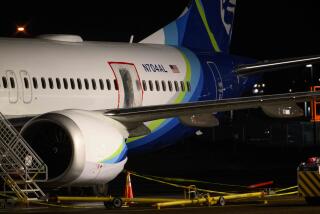New FAA Chief Vows ‘Top-to-Bottom’ Air Safety Campaign
WASHINGTON — The crackdown on Delta Airlines is the first step in an 18-month campaign to shape up the nation’s frequently criticized commercial air transport and air traffic control systems, according to the new chief executive of the Federal Aviation Administration.
“We are by no means restricting our efforts to Delta,” Allan McArtor, who took over last month as administrator of the FAA, said in an interview Friday.
“I’m going to have a top-to-bottom assessment of pilot training,” he said. “We simply have to impress upon our aviators the importance of staying on top of things every day, day in and day out. It’s the same kind of thing I’m going to insist on from our air traffic controllers, mechanics, technicians, flight attendants. . . .
“I’ve served notice to our airline industry that I intend to . . . make the senior executives of our air carriers feel just as accountable for their obligations under their operating certificates and maintenance programs as they feel personally accountable for reporting out the precise financial condition of their corporations,” McArtor said.
“I don’t feel that the portfolios of the shareholders are anymore important than the lives of the passengers.”
McArtor, 45, a former senior vice president of the Federal Express air freight and courier service and adviser to Transportation Secretary Elizabeth Dole, took over the FAA at a time when the agency has been under increased fire. Noting the continuing increase in air traffic delays, narrow misses between planes aloft and operational errors by the FAA’s air traffic controllers, Sen. Frank Lautenberg (D-N.J.), chairman of the Senate Appropriations Committee’s transportation subcommittee, warned McArtor that he is inheriting a “legacy of mismanagement and short-sighted policies” from an agency whose credibility is “on the line.”
Citing too much air traffic, a lack of effective traffic-flow control programs and too few qualified controllers at some FAA facilities, the National Transportation Safety Board said last May that there appears to be “an erosion of safety” in the air traffic control system.
Attention was focused Delta Airlines in recent weeks after a series of safety-related incidents involving the carrier, among them a pilot error that caused a Delta jetliner to plunge within 500 feet of the sea after takeoff from Los Angeles International Airport.
The FAA announced last month that it is initiating a systemwide investigation of the Atlanta-based carrier. On Friday, the agency announced that the pilot whose plane nearly plunged into the ocean will no longer be allowed to fly as an air line captain.
“No one is picking on Delta,” McArtor said.
“My personal view is that it’s a quality airline with quality management,” he said. “I do not consider the incidents to be isolated to Delta.
“They do point out, though, that there are breakdowns in crew vigilance and crew professionalism. . . . I believe that these things are happening with enough frequency in our system that we need a focused program to recommit our pilots to professionalism and to make sure that their training programs are the best possible.”
McArtor, who called his plans “innovative” half a dozen times during a 40-minute interview, is more of a creature of the ‘80s than the man he succeeded, former Navy Adm. Donald R. Engen.
Engen, who retired last month amid rumors that he was chafing under Dole’s short leash, is a Navy man of the old school--lean, flinty, ramrod straight, with a tendency toward plain-spoken candor that may have offended his superiors.
The tanned McArtor--whose carefully coiffed hair and impeccably tailored suits make him look of more like a successful California businessman than a Washington bureaucrat--seems more polished, more smilingly determined to cast his beleaguered agency in a positive light.
A graduate of the Air Force Academy and decorated combat pilot in Vietnam, McArtor served for two years as a member of the Air Force’s aerobatic Thunderbirds flying team. He was a senior vice president at Federal Express, where he played a key role in the company’s unsuccessful electronic “Zap Mail” program. Married, he has two teen-age sons.
Dole chose McArtor for his new job. The transportation secretary got to know him while he was serving--for the last year as chairman--on an advisory committee on commercial space transportation.
McArtor, who will have only the 18 months remaining in the Reagan Administration to achieve his goals, said his “Impact ‘88” campaign is being designed to achieve a “positive impact on safety and security and the modernization of our national airspace.”
He said the campaign will focus on the three elements in the national aviation system: “people, equipment and procedures.”
In addition to reevaluating the airlines’ training programs for people who fly and maintain aircraft, he said, the FAA will study better and quicker ways of recruiting and training controllers still needed to replace strikers fired by President Reagan after the Professional Air Traffic Controllers union strike in 1981.
“We don’t have enough controllers to take care of the growth of the system as it is occuring on a yearly basis,” McArtor said. “We’re going to place a new emphasis on the use of simulation technologies--the same as we use them for pilots. It would take less time than the (current) on-the-job training, turn out qualified controllers faster.”
He said improved training programs by both the carriers and the FAA should help reduce both pilot and controller errors. These errors, he said, are being studied “very seriously” in attempts to find new and better ways to avoid them.
Equipment Maintenance
As for equipment, he said, the FAA is going to make sure the airlines maintain planes “adequately and professionally,” and “we’re going to try to modernize our own equipment as rapidly as possible.”
The FAA, which is still operating some radar equipment dating to the 1950s and some radios older than that, has come under fire for its lagging replacement schedule. There are numerous complaints that the Aviation Trust Fund--with an unspent balance estimated at $6 billion to $11 billion--is being needlessly tied up by the Administration and Congress.
McArtor said “most” of the FAA’s equipment replacement plan is on schedule, and he is looking for ways to speed things up. “We’re looking at ways to chop the (development of) technology into more bite-sized chunks,” he said, “so we can get some benefits earlier, without waiting for each project to be completed.”
He said he will press the Administration and Congress as hard as he can to secure the release of the trust fund money.
As for the third focus of his campaign--procedures--McArtor said he is continuing the reconfiguration of airspace Engen launched in an effort to improve safety and reduce the confusion created as rules of right-of-way evolved over the years.
In the Los Angeles area, for example, new air routes for airlines approaching and leaving major airports have been adopted in an effort to reduce congestion and increase separation between commercial and private air traffic.
Clearer Boundaries
The FAA has proposed changes in the restricted airspace around Los Angeles International Airport. The changes are designed to make the airspace more easily recognizable to pilots. Last August’s disastrous collision between an Aeromexico jetliner and a light plane over Cerritos occurred after the small plane apparently strayed into restricted airspace. On Tuesday, the FAA will announce further changes in the restricted airspace over Southern California.
McArtor acknowledged the frequent delays experienced by air travelers, saying he did not wish to imply that airline service is good. “The public deserves a better-quality product,” he said.
He said, however, that a general tightening of the airlines’ procedures--rather than radical changes like abandonment of the government’s deregulation policy--are the answer.
“I feel that airlines should have to compete for their market share on a day-to-day basis,” he said.
More to Read
Sign up for Essential California
The most important California stories and recommendations in your inbox every morning.
You may occasionally receive promotional content from the Los Angeles Times.










